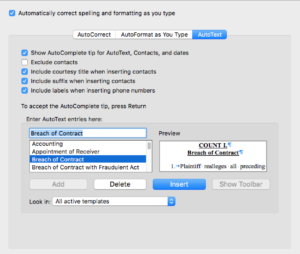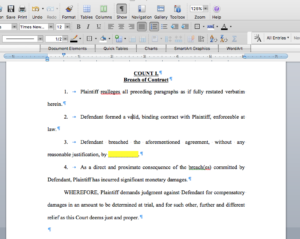[et_pb_section fb_built=”1″ _builder_version=”4.0.4″][et_pb_row _builder_version=”4.0.4″ column_structure=”2_3,1_3″][et_pb_column _builder_version=”4.0.4″ type=”2_3″][et_pb_text _builder_version=”3.27.4″ background_size=”initial” background_position=”top_left” background_repeat=”repeat” admin_label=”Text”]Ahh, go-bys. Since the dawn of Microsoft Word, lawyers have been copying and pasting from old documents to create new ones. Need to draft a motion for summary judgment? No problem — just pull up that brief you drafted last year, hit “save as,” shift a few things around, and voilà.
Well…maybe some problems. When you created that “new” document, you forgot to edit the case caption to reflect the correct court. Oh yeah, you also forgot to change the certificate of service to include the attorneys on this case. And you forgot to adjust gender pronouns as needed.

Go-bys can be helpful references for young lawyers, but without proper quality control procedures, they create a lot of potential for human error. Hopefully I can convince you that there’s a better way! Lawyers, I introduce to you the concept of document automation — the use of software and workflows to handle the routine, mundane tasks involved in document drafting.
Baby step: automatic numbering.
One of the simplest ways you can automate your documents — and one too often overlooked by lawyers — is by using the automatic numbering feature of your word processing software. I’m baffled at how many times I’ve read legal documents that omit or repeat a number in an ordered list. It’s 2017 — this should not be happening! 😃 Please promise me that whenever you use ordered lists, you will use automatic numbering!
Intermediate step: word processing templates.
Most word processing software allows for the creation of template files. In Microsoft Word, these are files with extensions like “.dot” or “.dotx.” Unlike a go-by, which will contain numerous things in need of changing, a template will contain blank spaces for case-specific information. This eliminates the potential that you’ll forget to change info in a document where necessary. A great template for any litigator to have is a pleading template, which contains placeholders for the case caption, pre-formatted double-spaced text, a signature block, and a certificate of service. I think you need it so badly that I made one for you to download! Just unzip it and then add it to your templates directory in your word processing software.
Advanced step: document parts.
Another feature of most word processing software is the ability to create a library of document parts. For instance, if you draft a lot of complaints, you might want to create a library of things like causes of action and jurisdictional allegations. Here’s an example of a cause of action “part” I created for breach-of-contract claims. All I have to do is select it from my library, then fill in the highlighted blank to include facts about the case.


Pro step: CMS integration.
If you want to play in the document automation big leagues, then develop a system that integrates with your case management system. The CMS we use, Clio, has a built-in document automation feature that allows us to map case metadata to our document templates. That means we can link up that pleading template I provided above to our CMS and automatically generate pleadings containing matter-specific info, such as the case number, party names, court, and so forth. As someone who has drafted hundreds (if not thousands) of pleadings, I can tell you that this is a huge time saver.
If you must use go-bys, then you must have quality control procedures.
Lawyers are creatures of habit, so go-bys probably aren’t going away anytime soon. If you’re going to use them, make sure you’re putting measures into place that guard against human error. The simplest, and perhaps most effective, quality control method out there is a checklist.
Feeling lost?
Lawyers, if you want to step up your document drafting game, but you’re intimidated by the concept of documentation, give us a call! We love helping our fellow barristers improve their systems and processes. Whether it’s helping you make better use of Microsoft Word or developing custom software for you, we’ve got your back!

[/et_pb_text][/et_pb_column][et_pb_column _builder_version=”4.0.4″ type=”1_3″][et_pb_cta _builder_version=”4.0.4″ hover_enabled=”0″ title=”Need help with document automation?” button_text=”Let’s talk” button_url=”@ET-DC@eyJkeW5hbWljIjp0cnVlLCJjb250ZW50IjoicG9zdF9saW5rX3VybF9wYWdlIiwic2V0dGluZ3MiOnsicG9zdF9pZCI6IjQwNCJ9fQ==@” _dynamic_attributes=”button_url” background_color=”#d6d6d6″ border_radii=”off|15px|15px|15px|15px” custom_padding=”30px|30px|30px|30px|true|true” background_layout=”light” header_text_color=”#0a0202″ custom_button=”on” button_text_color=”#ffffff” button_bg_color=”#0a0a0a” button_bg_enable_color=”on” button_border_color=”rgba(0,0,0,0)” button_border_radius=”10px” button_icon=”%%24%%” button_on_hover=”off”]
Document automation doesn’t have to be complicated. We can help your firm implement simple solutions that will send your productivity through the roof in as little as one week’s time.
[/et_pb_cta][/et_pb_column][/et_pb_row][/et_pb_section]




